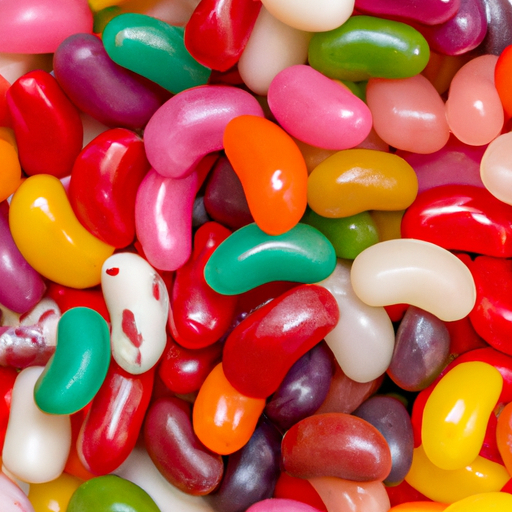Jellybeans: A Sweet and Colorful Delight
Jellybeans are more than just a mouthwatering treat. With their vibrant colors and irresistible flavors, these bite-sized candies have captured the hearts of people of all ages. But did you know that jellybeans can also be used in cooking to add a burst of sweetness to a variety of dishes? In this blog post, we will take a closer look at the taste, common culinary uses, nutritional value, and interesting facts about jellybeans.
Taste Explosion in Every Bite
Jellybeans are renowned for their extraordinary taste. Each small, oval-shaped candy is packed with a burst of flavor that dances across your taste buds. These delightful morsels come in a multitude of flavors, ranging from fruity delights like cherry, orange, and lemon to creamy treats like coconut, marshmallow, and even chocolate. Whether you prefer tangy, sour, or sweet, there’s a jellybean flavor that will satisfy your cravings.
A Touch of Sweetness in Culinary Creations
While jellybeans are commonly enjoyed on their own, they can also be incorporated into various culinary creations. Here are a few interesting ways to make the most of these colorful candies:
Cake Decorations: Give your cakes a playful twist by adorning them with jellybeans. The vibrant colors of these candies will instantly transform an ordinary cake into a visually stunning centerpiece.
Trail Mix: Add a hint of sweetness to your favorite trail mix by incorporating jellybeans. They provide an unexpected burst of flavor that pairs perfectly with nuts, dried fruits, and granola.
Ice Cream Toppings: Sprinkle some chopped jellybeans over your favorite ice cream for an added crunch and burst of sweetness. The creamy ice cream combined with the chewy texture of the candy creates a delightful sensory experience.
Cocktail Garnish: Take your cocktails to the next level by using jellybeans as a colorful and edible garnish. Simply slide a few onto a skewer and let them rest on the rim of the glass. Not only will they add a festive touch, but they’ll also infuse your drink with a hint of sweetness as they dissolve.
Nutritional Value of Jellybeans
While jellybeans may be a delightful indulgence, it’s important to keep in mind that they are high in sugar and calories. A standard serving of jellybeans (approximately 35 pieces) contains around 150 calories and 37 grams of sugar. They offer minimal nutritional value, lacking in vitamins, minerals, and fiber. As such, moderation is key when it comes to enjoying these colorful treats.
Fun Facts and History
Here are a few intriguing facts about jellybeans that might surprise you:
Jellybeans have a rich history dating back to the 17th century. Their evolution can be traced back to a popular Turkish candy known as Turkish delight.
During the American Civil War, jellybeans gained popularity as they were a favorite treat among soldiers thanks to their portability and long shelf life.
The inventor of the Jelly Belly brand, David Klein, once worked as a distributor for M&M’s before starting his own company and revolutionizing the world of jellybeans.
The most popular jellybean flavor in the United States is cherry, closely followed by lime, strawberry, and lemon.
The Jelly Belly company produces approximately 49 different flavors of jellybeans, including some unique ones like buttered popcorn, cinnamon, and blueberry pie.
Whether you enjoy jellybeans as a snack, a decorative element in cakes, or a playful addition to your cocktails, there’s no denying their popularity. These sweet and colorful candies have become an integral part of our culinary experiences, providing a burst of flavor and a touch of delight in every bite. So go ahead, embrace the jellybean craze, and explore the endless possibilities they offer in the world of cooking and confectionery.
Jellybeans
Origin: The exact origin of jellybeans is unclear, but they are thought to have evolved from a Middle Eastern confection known as Turkish Delight. Jellybeans as we know them today first appeared in the late 19th century in the United States.
Common Uses: Jellybeans are primarily known as a popular candy. They are often enjoyed as a sweet treat on their own, but they can also be used in baking, cake decorating, and as an ingredient in festive recipes.
Nutritional Benefits: While jellybeans are tasty, they are not particularly nutritious. They are high in sugar and provide little nutritional value. They are considered to be a source of empty calories and are best enjoyed in moderation.
Unique Properties: Jellybeans have a distinctive shape and a hard sugar shell with a soft and chewy interior. They come in a wide variety of colors and flavors, making them visually appealing to many people.
Historical Significance: During the American Civil War, jellybeans became popular among soldiers who appreciated their long shelf life and portability. In more recent times, jellybeans gained cultural significance when they were used by President Ronald Reagan as his favorite candy during his time in office. Jelly Belly, one of the most popular brands of jellybeans, was also used by NASA as “space beans” during space missions for its quick energy and ability to withstand extreme conditions.




Use the share button below if you liked it.
It makes me smile, when I see it.